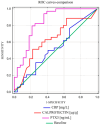The Impact of Pentraxin 3 on Crohn's Disease Phenotype
- PMID: 39519095
- PMCID: PMC11546887
- DOI: 10.3390/ijms252111544
The Impact of Pentraxin 3 on Crohn's Disease Phenotype
Abstract
Pentraxin 3 [PTX3] is an acute-phase protein playing an important role in the regulation of the humoral arm of immune response. As one of the molecules from the conservative family of pentraxins, PTX3 is a soluble mediator involved in the transduction of pro-inflammatory signals between immunocompetent cells. Additionally, recognizing damage-associated molecular patterns (DAMPs) during tissue injury mediates wound healing; therefore, its concentration potentially correlates with the severity of fibrosis. The aim of our study was to evaluate the value of the PTX3 measurement as a phenotypic marker of the stenotic form of Crohn's disease. The research covered 63 patients, 35 with the narrowing type (B2) and 28 with the inflammatory type (B2) of CD. The mean concentrations of PTX3 in the study were as follows: 3.06 ng/mL (95% CI: 1.27-6.99) for the B1 phenotype, 4.89 ng/mL (95% CI: 2.98-13.65) for the B2 phenotype, and 3.04 ng/mL (95% CI: 1.01-4.97) for the control group. PTX3 concentrations reached the highest values in the B2 group and the lowest in the control group. The differences between the B1 and B2 groups were statistically significant at p < 0.001. The presented studies indicate the potential role of PTX3 in the monitoring of tissue remodeling and the development of fibrosis in CD.
Keywords: children’s gastrointestinal tract; pentraxin 3 [PTX3]; phenotypes of Crohn’s disease.
Conflict of interest statement
The authors declare no conflicts of interest.
Figures
Similar articles
-
Serum pentraxin 3 is a novel marker in Crohn's disease.Mol Med Rep. 2015 Jul;12(1):543-6. doi: 10.3892/mmr.2015.3451. Epub 2015 Mar 6. Mol Med Rep. 2015. PMID: 25760650
-
Pentraxin levels in non-eosinophilic versus eosinophilic asthma.Clin Exp Allergy. 2018 Aug;48(8):981-989. doi: 10.1111/cea.13168. Epub 2018 Jun 19. Clin Exp Allergy. 2018. PMID: 29754456
-
Pentraxin-3 serum levels are associated with disease severity and mortality in patients with systemic inflammatory response syndrome.PLoS One. 2013 Sep 9;8(9):e73119. doi: 10.1371/journal.pone.0073119. eCollection 2013. PLoS One. 2013. PMID: 24039869 Free PMC article.
-
The Long Pentraxin PTX3 as a Humoral Innate Immunity Functional Player and Biomarker of Infections and Sepsis.Front Immunol. 2019 Apr 12;10:794. doi: 10.3389/fimmu.2019.00794. eCollection 2019. Front Immunol. 2019. PMID: 31031772 Free PMC article. Review.
-
The long pentraxin PTX3 in vascular pathology.Vascul Pharmacol. 2006 Nov;45(5):326-30. doi: 10.1016/j.vph.2006.08.011. Epub 2006 Aug 23. Vascul Pharmacol. 2006. PMID: 17023219 Review.
Cited by
-
Expression of the IL-18-related gene PTX3 correlates with clinicopathological features and prognosis in glioma patients.PeerJ. 2025 Jul 10;13:e19675. doi: 10.7717/peerj.19675. eCollection 2025. PeerJ. 2025. PMID: 40656950 Free PMC article.
References
-
- Nissilä E., Korpela K., Lokki A.I., Paakkanen R., Jokiranta S., de Vos W.M., Lokki M.L., Kolho K.L., Meri S. C4B gene in-fluences intestinal microbiota through complement activation in patients with paediatric-onset inflammatory bowel disease. Clin. Exp. Immunol. 2017;190:394–405. doi: 10.1111/cei.13040. - DOI - PMC - PubMed
MeSH terms
Substances
Grants and funding
LinkOut - more resources
Full Text Sources
Medical
Research Materials
Miscellaneous


